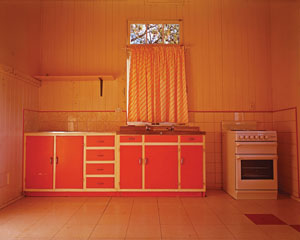
In the history of art the window holds much symbolic importance. In the Romantic tradition the view from the window of an artist's studio, for example Caspar David Friedrich's circa 1818 Studio Window, was a window metaphorically into the psyche of the artist and viewer. This symbolic power had, and still has, quite obvious correlations to the picture frame. For Odilon Redon, at the end of the nineteenth-century, the window also became the framing device that captured reality within its constraints. It is this dual nature of representing the real and the symbolic that indirectly informs this ten year survey exhibition of the photography of Queenslander Annie Hogan. Now living in North Carolina, USA, Hogan teaches in the photography department of the School of Art and Design, East Carolina University. After winning a Samstag International Visual Arts Scholarship in 2002, Hogan has gone on to further her interest in the vestiges of lived experience and incarceration within the built environment.
Where Redon wanted to capture reality in an instant, Hogan metaphorically and literally wishes to close this aspect of the window. The symbolist properties of the window as an escape from the confinement of an interior form a central pillar of Hogan's oeuvre. Yet she denies any visual escape through the paradoxical presence of draped curtains, frosted glass and iron bars. The sites Hogan chooses are a mix of domestic and prison interiors, the obvious distinctions between the two are blurred. Thus is made evident a denial of the reality of the outside as the confinement of the many rooms and cells force the viewer into a conceptual interior space.
In Dreaming of Luna Park (2007) light is cast across a wall with an indirect view of a window. Like a strange projector the light casts reflections of something, blurry and incoherent, hardly representative of Luna Park. For the window is at once an aperture and a reflection. The work thus proves to be incredibly beguiling as it denies one half of this dual nature by closing the point of escape. The viewer is unable to escape, restrained by being disconnected from the reality of an exterior view. The reflections of the mirror-like window are the only consolation.
A large window controls the entire image in Field of Mine (2005) and light seeps in from behind a heavy roller blind and wispy tulle drapes. The room itself, as in the major proportion of Hogan's work, is absent of any furniture. The light that spills from the edges of the curtain works to illuminate the dirty confines of the bedroom, giving it shape, structure and form. Here the exterior in the form of light informs the interior and the presence of the outside taunts the trapped viewer with apparent purpose and meaning.
Untitled 5 from The Big Silence series (1997) is the only work in the survey that allows a sliver of insight into the inner workings of Hogan's mind. Growing up in a household of thirteen children, the artist states in a video interview accompanying the exhibition that the kitchen was the centre of their household, a place of fire and passion. The interest in Untitled 5 lies in the presence of actual furniture in the form of a neon-orange kitchen bench, a homely oven and a tentative view of the outside. Eucalyptus leaves and branches hang in front of a pure blue sky, a fragmentary memory of Australia that forms the centre of this most personal of Hogan's works in the show. This scrap of sky is the only escape ever presented by Hogan. Here the most discomforting nature of her work becomes evident. The absence of frame, the absence of narrative and the absence of content, in the majority her work, formulate the very claustrophobic interior nature of her aesthetic. We rely upon these visual rights and when they are denied it proves to be a strangely haunting experience, becoming a reflection on the unlawful incarceration of the mind and body that Hogan finds so repellent in the contemporary world.












